Where to Stay in Dublin – A Guide to the Capital of Ireland
Dublin is a city located on Ireland’s east coast, at the mouth of the River Liffey. It is the largest and most populated city on the island of Ireland and one of the most important industrial, transport, business and cultural centres in Europe. From a tourist point of view, Dublin is famous for its museums, lovely parks, legendary nightlife, and for being the birthplace of Guinness beer. In this article, we will explore the best areas to stay in Dublin, Ireland.
Why you should visit Dublin
The Irish capital is one of the most exciting places in Europe. A perfect mix of old town charm, industrial grit, and contemporary, fast-paced city life, together with one of the most iconic nightlife scenes in the world has turned this city into one of the most visited tourist destinations in the EU. Over 5 million visitors from all over the world come to Dublin each year to have a taste of the real Irish experience. Find accommodation in Dublin City Centre.
Dublin is thought to have its origins in a Celtic settlement established around the 7th century. The city was also occupied by Vikings and Normans, and, by the 18th century, it had become one of the most important urban centres on the British Isles. In the early 20th century, after the partition of Ireland, Dublin became the capital of the newly created Irish Free State, now the Republic of Ireland.
The most important historic and cultural attractions in Dublin City Centre include Dublin Castle, Kilmainham Gaol, St Patrick’s Cathedral, Christ Church Cathedral and The Custom House. Dublin is also known for its many museums, art galleries and cultural attractions. Some of the most popular museums in Dublin include the National Gallery of Ireland, the Irish Museum of Modern Art, the Chester Beatty, The Irish Emigration Museum, The Little Museum of Dublin and the Dublin Writers Museum. Find accommodation in Dublin City Centre.
If you like parks and greenery, you’ll be thrilled to know that Dublin is home to some of the most beautiful urban parks and green spaces in all of Europe. Some of the loveliest parks in Dublin are St. Stephen’s Green, Phoenix Park, Merrion Square, Iveagh Gardens and the National Botanic Gardens.
Furthermore, a visit to Dublin wouldn’t be complete without a tour of Guinness Storehouse. This Dublin attraction, the most visited tourist site in Ireland, offers the opportunity to discover the Irish capital’s industrial heritage and the history behind Ireland’s most famous beer brand. Find accommodation near Guinness Storehouse.
Lastly, as Ireland’s capital, Dublin is the main gateway to explore the amazing sights this gorgeous country has to offer. If you’re travelling from outside Ireland, chances are you are arriving at or departing from Dublin International Airport. If that’s the case, and you’re just briefly stopping in Dublin on your way to the Wild Atlantic Way or the Cliffs of Moher, you may want to look for accommodation near Dublin airport or Heuston Train Station.
When to visit Dublin
Like most of Ireland, Dublin experiences a maritime climate with conditions moderated by the Gulf Stream’s influence. This translates into mildly warm summers and cool winters. Temperatures during the summer usually range between 12 and 20 ºC. On the other hand, winters can see temperatures of around 2 – 9 ºC. The best time to visit Dublin is during the summer (between June and September), when the pleasant temperatures are great for sightseeing and outdoor activities.
Dublin: Getting there and around
To get to Dublin via air, the city is home to Dublin International Airport (DUB). Located around 10 kilometres north of the city centre, this airport serves as the home base of Irish flag carrier Aer Lingus and low-cost airline Ryanair. Dublin International Airport is the 8th-busiest airport in the EU and connects the Irish capital with hundreds of destinations across the British Isles, Europe and North America.
Dublin is also well-connected to the rest of Ireland by train services. Heuston Station, located directly west of the city centre, offers Intercity connections to Cork, Limerick, Waterford, Galway, Mayo, and Kerry, as well as commuter rail services to nearby towns and suburbs. Additionally, several coach routes link the capital with the main tourist towns in and cities in Ireland. Check train and coach schedules, routes and fares.
You can also get to Dublin by ferry. Frequent ferry services link the Irish capital to various ports in Great Britain (Holyhead, Liverpool/Bootle), France (Cherbourg) and the Isle of Man (Douglas). See ferry schedules, routes and fares.
To move around the city, Dublin has a multimodal public transportation system consisting of a light-rail network, a suburban commuter system, and over 100 urban bus lines. To explore the outlying suburbs or natural wonders around Dublin, you may also choose to rent a car for your stay.
Where to stay in Dublin
The best area to stay in Dublin is hands down the City Centre. Dublin’s central districts are home to most of the cultural and historical attractions in the city, as well as the main shopping and nightlife areas (including Temple Bar). Dublin’s City Centre is also the best-connected district of the city and where the best hotels are located. Find accommodation in Dublin City Centre.
Some of the central districts that you should definitely consider when choosing the best location in Dublin include Temple Bar, Saint Stephen’s Green, The Docklands and Stoneybatter & Smithfield.
Historically, Dublin has experienced a strong socio-economic divide between north and south. With River Liffey acting as the border, Dublin’s Northside has traditionally been a working-class area, while the Southside is regarded as a place for the upper and upper-middle classes. As a result, most of the grand palaces, administrative buildings, shopping areas and cultural attractions are located south of the river. That said, Northside Dublin has a lot to offer. With the north concentrating most of the up-and-coming districts, new business hubs and exciting urban redevelopment projects, Finding the best area to stay in Dublin will boil down to your personal taste and budget. Find accommodation in Southside Dublin | Find accommodation in Northside Dublin.
Other excellent areas outside the City Centre to keep in mind when choosing the best areas to stay in Dublin for tourists are the Dublin Port, Ballsbridge, Drumcondra, Rathmines and City West.
Keep reading to learn more about the best areas to stay in Dublin, Ireland.

Best Location in Dublin, Ireland: A Quick Guide
Below, you’ll find a list of the best areas to stay in Dublin according to your travel style and what you may be planning to do during your trip. Keep reading this guide to find all the specific information you need about each particular area mentioned here.
- Best location in Dublin for sightseeing: Dublin City Centre
- Best location in Dublin for nightlife: Temple Bar
- Best location in Dublin for shopping: St Stephen’s Green
- Best location in Dublin for families: Dublin City Centre
- Best location in Dublin without a car: Dublin City Centre
- Best location in Dublin for first-time visitors: Dublin Old Town
- Best location in Dublin for business travellers: Dublin Docklands & IFSC
- Best location in Dublin on a budget: Drumcondra
- Best location in Dublin for hipsters: Smithfield & Stoneybatter
- Best location in Dublin for LGBTQ travellers: Temple Bar
The Best Hotels in Dublin
Something more specific in mind? Here’s a list of some of the best hotels in Dublin. No matter your reason for visiting the city or style, you’ll find it here!
- Most unique hotel: Moxy Dublin City
- Coolest hotel: Generator Dublin
- Best traditional hotel: The Ferryman Townhouse
- Best mid-priced hotel: Holiday Inn Express Dublin City Centre, an IHG Hotel
- Best budget hotel: The Leeson Lodge
- Best luxury hotel: The Marker Hotel – A Leading Hotel of the World
- Best boutique hotel: The Mayson
- Best hotel with a pool: Camden Court Hotel
- Best business hotel: Marlin Hotel Stephens Green
- Best B&B: Gardiner Lodge
- Best hostel: Jacobs Inn Hostel
The Best Areas to Stay in Dublin, Ireland
1. Recommended area: Dublin City Centre
Dublin’s city centre, as is to be expected, is home to some of Dublin’s oldest and liveliest neighbourhoods.
Situated on both sides of the River Liffey, Dublin City Centre is characterised by its collection of Georgian and Victorian buildings, narrow streets, shady squares and green parks.
Dublin’s Old Town, which roughly stretches from Thomas Street east to Dubh Linn Garden, is home to the city’s surviving medieval landmarks, such as Christ Church Cathedral, St. Audoen’s Church, St Patrick’s Cathedral and Dublin Castle.
One of Dublin’s most recognisable landmarks, Dublin Castle was originally built in the early 13th century on the site of an earlier Viking settlement. Until 1922 it served as the seat of the British government’s administration. Today, the castle is a major tourist attraction and hosts two museums (Garda and Revenue Museums), frequent art exhibitions and concerts. Right next to it, the Chester Beatty Library displays an exceptional collection of rare manuscripts and works of art.
Further east lies the impressive Trinity College Dublin. Established in 1592 and regarded as one of Europe’s elite universities, this elegant campus is home to several museums and the impressive Old Library, which displays the famous Book of Kells, a 9th-century manuscript containing the four Gospels of the New Testament.
The area between the Trinity campus and the castle is Dublin’s commercial core. This area, which stands out for its lovely Georgian and Victorian buildings, is home to the city’s main shopping streets such as Grafton Street and Kings Street.
Nearby, the National Gallery of Ireland, Dublin’s main art institution, offers an impressive collection of European art from the 14th to the 20th century. Meanwhile, the National Museum of Ireland – Archaeology is home to Bronze Age, Viking and Medieval artefacts, and also has a small Egyptian collection.
North of this area lies Temple Bar, Dublin’s most famous nightlife area. We’ll cover that area below.
The Guinness Storehouse, located west of the Old Town is Dublin’s most visited tourist attraction. Here, you can learn everything you always wanted to known about Ireland’s most famous beer. Book skip-the-queue tickets for the Guinness Storehouse here.
North of the River Liffey you’ll find Dublin’s hip up-and-coming areas like Smithfield and Stoneybatter, former industrial districts turned into creative hubs home to the local hipsters.
The Northside is also home to tourist attractions such as Phoenix Park, the Jameson Distillery, The Custom House or EPIC – The Irish Emigration Museum.
Dublin City Centre is vibrant and compact enough that you can easily get around on foot. If you prefer to use public transport, the area is served by buses, the Luas and commuter train services.
Heuston Station, Dublin’s main Intercity train station, is located west of the city centre.

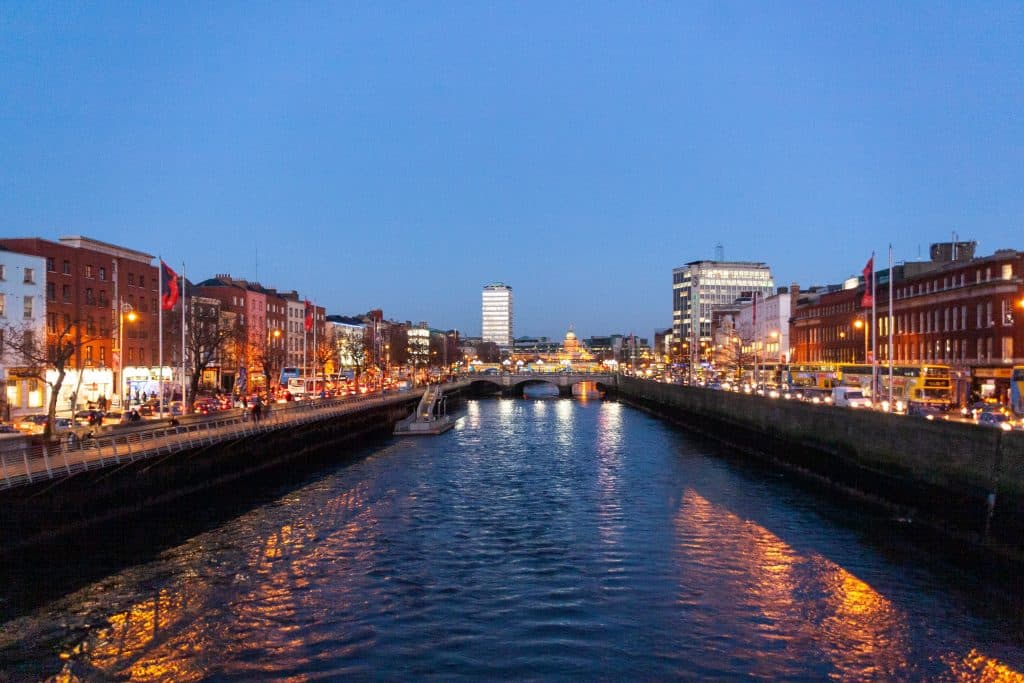
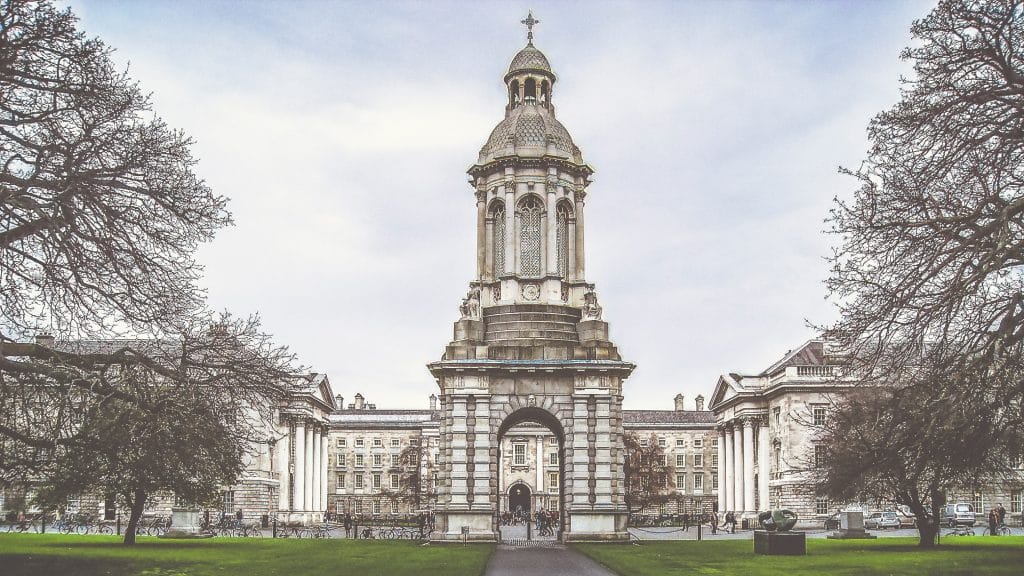

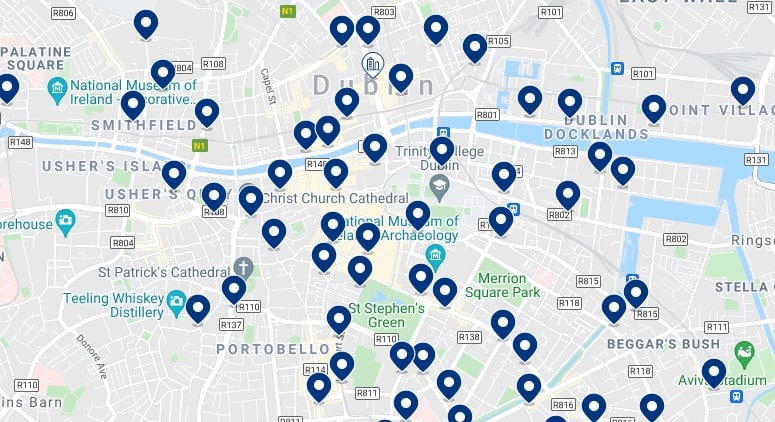
Where to stay in Dublin City Centre
- Dublin Old Town
- Around Trinity College
- Around the Guinness Storehouse
- Parnell Square (Northside)
- Around Heuston Station
Why is this a recommended area to stay in Dublin, Ireland:
- Heart of the city
- Main shopping streets
- Medieval attractions
- Trinity College
- Very well-connected by public transport
- Museums and cultural attractions
Accommodation in this area
-
Top Choice
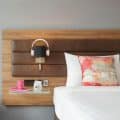
Moxy Dublin City
Ideally set in the centre of Dublin, Moxy Dublin City features air-conditioned rooms, a bar, free WiFi and a shared lounge. All rooms boast a flat-screen TV with satellite channels and a private bathroom.
-
Budget

Holiday Inn Express Dublin City Centre, an IHG Hotel
Holiday Inn Express Dublin City Centre is situated in Dublin on O’Connell Street, 800 m from Temple Bar, with free WiFi and breakfast included. The property offers 198 rooms, with each room containing en-suite facilities, a flat-screen TV, air-conditioning and a movable desk.
-
Luxury
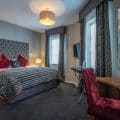
Riu Plaza The Gresham Dublin
Situated in the heart of Dublin city centre in a historic building, The Gresham Hotel benefits from its own restaurant ‘Toddy’s’, and a bar. The hotel offers free WiFi and spacious rooms overlooking O’Connell Street. Dublin 3Arena is 1.6 km away.
2. Temple Bar
Dublin’s Temple Bar area is one of the best-known neighbourhoods of the Irish capital.
This lively nightlife district is located in the heart of Dublin, on the south bank of River Liffey and is one of the oldest parts of Dublin.
Temple Bar is mostly famous for its large concentration of pubs, bars, clubs and restaurants and, as such, is the best area to stay in Dublin for nightlife.
The nightlife scene in Temple Bar is quite varied and caters to all types of people. While traditional Irish pubs are very popular, this area is also home to several live music spots, posh cocktail bars, and old industrial warehouses turned into nightclubs and concert venues.
Temple Bar is also home to the main LGBTQ nightlife area in Dublin. Located on South Great George’s Street and founded in 1985, The George (Ireland’s oldest gay club) has been a haven for the queer community long before homosexuality was even legal in Ireland.
Temple Bar is also considered Dublin’s restaurant area par excellence. Here, you can find anything from traditional Irish to the most exclusive seafood restaurants, greasy spoons, fast-food joints international eateries and everything in between.
Because Temple Bar is a lively fashionable area in the centre of Dublin, its accommodation offer is very varied. Here, you can find lots of midrange and luxury hotels, exclusive tourist apartments and quite a few trendy hostels and inns.

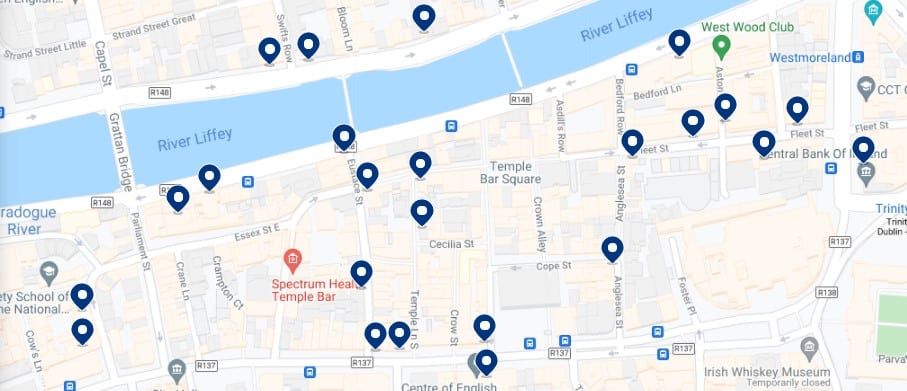
Why is this a recommended area to stay in Dublin, Ireland:
- Dublin City Centre
- Best area for nightlife in Dublin
- Dublin’s LGBT area
- Restaurants and shopping areas
- Great transport connections
Accommodation in this area
-
Top Choice
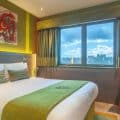
Temple Bar Inn
Located in Dublin, the chic Temple Bar Inn offers free WiFi access throughout and a 24-hour front desk. The popular O’Connell Street and Trinity College are both a 3-minute walk away.
-
Budget

Abigail’s Hostel
Just seconds from cultural Temple Bar, Abigail’s Hostel has an excellent city-centre location on Aston Quay, overlooking the River Liffey.
-
Luxury
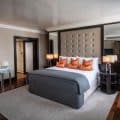
The Westbury Hotel
The luxurious 5-star Westbury Hotel has spacious and sumptuously furnished bedrooms with en suite bathrooms. On Dublin’s Grafton Street, the Westbury has fantastic restaurants, a bar and a fitness suite.
3. St Stephen’s Green
Opened to the public in 1880, Saint Stephen’s Green is a garden located in Dublin City Centre.
This lovely city park is the largest of Dublin’s main Georgian squares. Others include nearby Fitzwilliam Square and Merrion Square.
Saint Stephen’s Green, locally known simply as Stephen’s Green is very close to Dublin’s main shopping streets like Grafton Street and adjacent to Stephen’s Green Shopping Centre, one of the most popular malls in town.
Set in the heart of Georgian Dublin, the neighbourhoods surrounding this park are some of the most exclusive in the Irish capital. As a result, this area hosts a lot of luxurious hotels and upscale tourist apartments.
This area is also considered Dublin’s cultural hub; home to many museums, art galleries and concert halls. Some of the most important tourist attractions in this area include the National Gallery of Ireland, the National Museum of Ireland – Archaeology, The Little Museum of Dublin, the Museum of Literature Ireland and the National Concert Hall.
The Portobello district, southwest of the Green, is Dublin’s Jewish Quarter and a lively food and nightlife area.
Saint Stephen’s Green is very central and well-connected by the Luas system. Walking from this area to Temple Bar shouldn’t take more than 15 minutes.
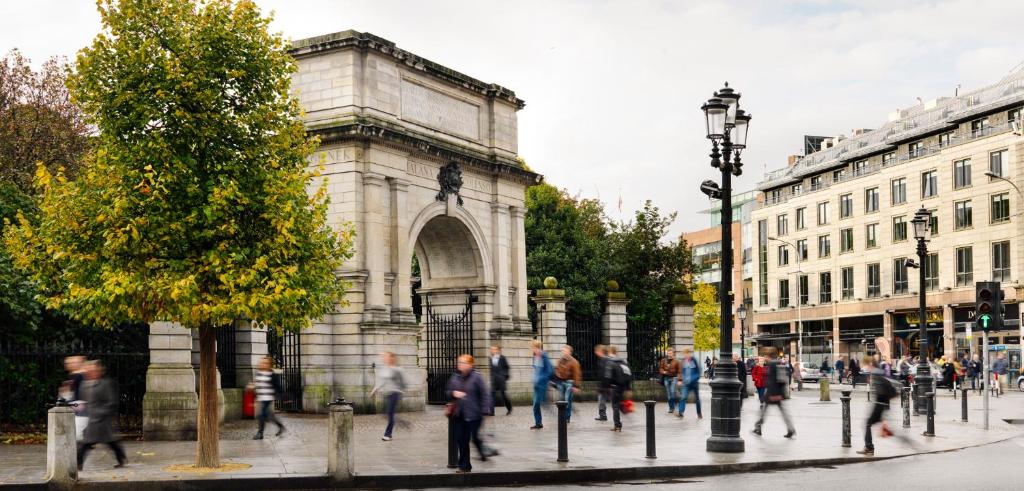

Why is this a recommended area to stay in Dublin, Ireland:
- Dublin City Centre
- Upscale area
- Luxurious hotels
- Shopping areas and restaurants
Accommodation in this area
-
Top Choice
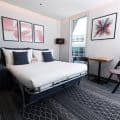
Marlin Hotel Stephens Green
Marlin Hotel Dublin is in a prime location in the centre of Dublin, 400 m from Dublin Castle. 600 m from St. Stephen’s Green, the hotel offers a fitness centre and a bar. The accommodation provides free WiFi.
-
Budget
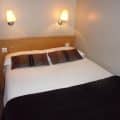
Leeson Inn Downtown
Set in a 19th Century Georgian building, The Leeson Inn Downtown is located southeast of Dublin city centre on Leeson Street next to cafes, restaurants, bars and nightclubs.
-
Luxury

The Fitzwilliam Hotel
In central Dublin, The 5-star Fitzwilliam Hotel offers luxurious accommodation. Guests can enjoy the restaurant and bar There is a gym, and the hotel’s interior design is by Sir Terence Conran.
4. International Financial Services Centre, The Docklands & Dublin Port
Dublin’s International Financial Services Centre (IFSC) is a business district created in the late 1980s to accommodate the city’s booming financial and technology industries.
This business centre, located in the North Wall area, near the port, quickly became one of the fastest-growing districts in Dublin and included congress venues, office towers, retail spaces and leisure areas.
The IFSC is also home to some attractions such as the Irish Emigration Museum, the Jeanie Johnston ship and Samuel Beckett Bridge.
In the last two decades, Dublin’s business district has expanded further east and south.
As a result, the Dublin Docklands have seen many new developments and avant-garde office towers, modern squares, shopping centres and cultural landmarks have opened everywhere in the district.
As it couldn’t be otherwise, The Docklands are home to some of Dublin’s top-rated business hotels and upscale modern tourist apartments.
The whole Docklands area is extremely well-served by Dublin’s public transport network; Connolly Station, located west offers commuter and Dart railway services and the Red Line of the Luas goes through the IFSC. The area around the Grand Canal also has train links.
As an added bonus, the Docklands area is very close to the Port of Dublin and its many passenger terminals, so it’s a great area to stay if you’re planning to take a cruise or a ferry.
The Dublin Docklands is the best area to stay in Dublin for business travellers.



Why is this a recommended area to stay in Dublin, Ireland:
- Modern, upscale area to stay in Dublin
- Best area for business travellers
- Dublin Port
- Connected by public transport
Accommodation in this area
-
Top Choice

The Mayson
The Mayson has a restaurant, outdoor swimming pool, a fitness centre and bar in Dublin. This 4-star hotel offers a 24-hour front desk, room service and free WiFi. The property is allergy-free and is situated 2.7 km from Poolbeg Beach.
-
Budget

The Ferryman Townhouse
Comprised of 2 restored listed Georgian buildings, The Ferryman Townhouse overlooks the River Liffey. Good-value rooms and a lively pub are just a kilometer from Dublin’s centre.
-
Luxury

The Marker Hotel – A Leading Hotel of the World
Situated on Grand Canal Square in the heart of Dublin’s business and cultural quarter, The Marker features a ground-floor cocktail bar & brasserie, free WiFi and a spa with 5 treatment rooms and a state-of-the-art gym. The property also boasts a 23 m infinity pool, sauna, steam room and fitness centre.
5. Smithfield & Stoneybatter
Smithfield and Stoneybatter are located very close to Dublin City Centre, north of the River Liffey and directly east of Phoenix Park.
These Northside neighbourhoods, traditionally regarded as working-class, industrial areas are now considered Dublin’s creative epicentre.
Smithfield is the area closest to the river. This revitalised industrial district is known for landmarks such as the Old Jameson Whiskey Distillery, the Observation Tower and the National Museum of Ireland – Decorative Arts & History.
Further north lies Stoneybatter, Dublin’s “hipster quarter.” Like many other alternative districts around the world, this area has gone through a gentrification process to become one of the most desirable districts in Dublin, especially among young people.
Oftentimes called “the ’Batter,” this up-and-coming district is the place to go for ethnic food, thrift shopping, cool cafés, speciality stores and anything hipster-related.
West of Stoneybatter lies the massive Phoenix Park. Its 707 hectares make it the largest enclosed city park in Europe. Phoenix Park contains large areas of grassland, tree-lined avenues, wild fallow deer and a number of stately homes, including the Irish president’s home (Áras an Uachtaráin), Farmleigh House and the US Ambassador’s residence.
Smithfield is connected to the rest of Dublin through Museum station (Luas Red Line) and is also within walking distance from Heuston Station (located on the other side of the river). The easiest way to get around Stoneybatter is by bus or taxi.


Why is this a recommended area to stay in Dublin:
- Dublin’s hipster area
- Cool hotels and hostels
- Restaurants, Cafés and nightlife
- Old Jameson Whiskey Distillery
- Phoenix Park
Accommodation in this area
-
Top Choice
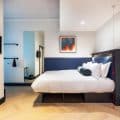
The Hendrick Smithfield
Attractively situated in the centre of Dublin, The Hendrick Smithfield features air-conditioned rooms, a bar, free WiFi and a terrace. This property is situated a short distance from attractions such as The City Hall, Guinness Storehouse, and Dublin Castle.
-
Budget

Generator Dublin
The award-winning Generator Dublin is located right next to the Jameson Distillery and just beside the Smithfield LUAS stop, offering you easy access to every part of the city.
-
Luxury

Tipperary House Dublin
Situated on the banks of the River Liffey, the Tipperary House Dublin is opposite Heuston Railway Station and the Airlink bus stop. With free Wi-Fi throughout, it is just 10 minutes’ walk from the Guiness Brewery.
6. Ballsbridge
Ballsbridge is located southeast of Dublin City Centre.
This upscale area is known for its many shady parks, stately homes, embassies and business centres.
At its centre lies Herbert Park. This massive green space was home to the 1907 Irish International Exhibition and is one of Dublin’s most beautiful urban parks. It includes playgrounds, several formal gardens, sports facilities and a large duck pond.
Ailesbury Road, one of the most expensive streets in the world, is home to several embassies and diplomatic bodies. Nearby, the Embassy of the United States of America is a notable landmark thanks to its avant-garde cylindrical shape.
The RDS Arena holds major sporting and music events, while nearby Aviva Stadium is used for football and rugby matches, as well as large concerts.
Several big technology companies like Facebook and Google have campuses in Ballsbridge or nearby.
The DART train network (Lansdowne Road and Sandymount stations) connects the eastern part of Ballsbridge to the rest of Dublin and beyond.
Accommodation in this area
-
Top Choice

Park Residence at Herbert Park Hotel
Set in Dublin, 2.6 km from Poolbeg Beach, Park Residence at Herbert Park Hotel offers accommodation with a restaurant, private parking, a bar and a garden. Among the facilities at this property are a 24-hour front desk and room service, along with free WiFi throughout the property.
-
Budget
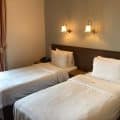
The Leeson Lodge
The Leeson Lodge is a family-run guesthouse located in the quieter Georgian Quarter of Dublin’s city centre. Less than 15 minutes’ walk from Stephens Green, it offers pleasant accommodation in a historic period building.
-
Luxury

Clayton Hotel Ballsbridge
Boasting spacious rooms with en suite bathrooms, Clayton Hotel, Ballsbridge is a beautifully restored 19th-century Masonic orphan’s school with landscaped gardens. Located less than 5 minutes’ walk from the RDS, the city buses stop right outside the hotel.
7. Drumcondra
Drumcondra is a mainly residential suburb located in Northside Dublin.
Drumcondra’s main tourist attraction is probably Croke Park. With over 82,000 seats, this major stadium is the largest sports venue in Ireland and hosts GAA (Gaelic football, hurling, handball and camogie) events from April to September.
The Croke Park complex is also home to the GAA Museum, the Irish Handball Centre and a 4-star hotel (The Croke Park Hotel).
A couple of kilometres northwest of Croke Park lie the National Botanic Gardens. This lovely park offers hundreds of local and exotic plants, Victorian gardens, an arboretum and a greenhouse.
Drumcondra Station, located a few blocks west of the stadium, offers commuter services to Connolly Station and Phoenix Park. For Central Dublin destinations, there are several bus stops along the main thoroughfares like Drumcondra Rd. or Botanic Rd.
Drumcondra is not the most centrally-located district on this list of the best areas to stay in Dublin. That said, this neighbourhood offers cheap accommodation, a quiet suburban atmosphere and is a great district to stay in the Irish capital for Gaelic sports fans.
Accommodation in this area
-
Top Choice

The Croke Park Hotel
Opposite Croke Park Stadium, this luxury 4-star hotel boasts spacious rooms with 50-inch Smart TVs. Guests can enjoy hot towels on arrival, free parking, and a European bistro.
-
Budget
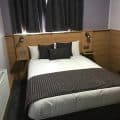
Kennedys B&B Drumcondra
Located within 1 km of Croke Park Stadium and 2.7 km of EPIC The Irish Emigration Museum in Dublin, Kennedys B&B Drumcondra provides accommodation with free WiFi and flat-screen TV.
-
Luxury

Dublin Skylon Hotel
Located in the heart of Drumcondra village, the Dublin Skylon Hotel is a family run hotel situated next to many famous Dublin landmarks. National Botanic Gardens, Glasnevin Cemetery & Croke Park Stadium can be reached in 15 minutes on foot, while Dublin City University (DCU) is located just 10 minute walk.
8. Rathmines
Rathmines is an inner suburb in Dublin’s Southside.
It is located about 3 kilometres south of the City Centre.
Traditionally a lower-middle-class suburb, in recent times, the area has gone through a gentrification process to become one of the most cosmopolitan and diverse areas in the Irish capital.
Rathmines is home to a few local attractions such as the Cathal Brugha Barracks, the Rathmines Library and the Church of Mary Immaculate.
To move around the area and reach Dublin City Centre, Rathmines is served by the Luas light rail system and there are several bus lines also covering the area.
Accommodation in this area
-
Top Choice

Uppercross House Hotel
Built in the 1800s, the recently restored Uppercross House Hotel is located in bustling Rathmines, just over the canal on Dublin’s south side. A bus stop and taxi rank are just outside the door and can reach the city centre in 5 minutes.
-
Budget

Travelodge Dublin City Rathmines
Situated just 15 minutes’ walk from St Stephen’s Green, the Travelodge Dublin City Rathmines offers budget rooms with power showers. Dublin’s centre is 2 km away from the hotel, and buses outside stop every 5 minutes.
-
Luxury

The Devlin Dublin
Situated in Dublin, 1.6 km from RDS, The Devlin features views of the city. 2.3 km from Grand Canal, the hotel features a rooftop bar and restaurant, as well as a cinema. The Little Museum of Dublin is 2.3 km from the hotel.
9. Around Dublin Airport
Dublin Airport is the airport serving the city of Dublin. It is located in Collinstown, 7 km north of Dublin City Centre.
This major international airport, the busiest in Ireland and one of the busiest in the European Union, serves as the main hub for several airlines including the Irish flag carrier Aer Lingus and low-cost airline Ryanair.
This airport offers a wide variety of short and medium-haul flights, as well as a growing long-haul network focused mainly on North American and Middle East destinations.
Serving as the main gateway to Europe to thousands of people arriving from the US and Canada, the area around Dublin Airport is the best location to stay in Dublin during a layover.

Read in other languages:



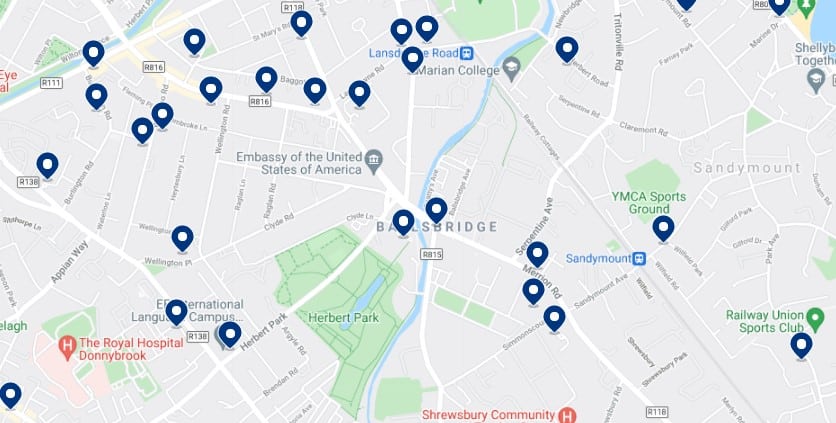

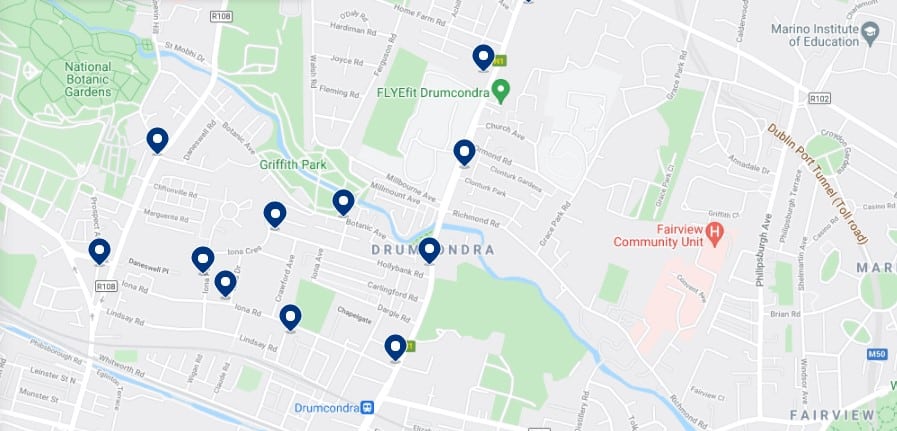



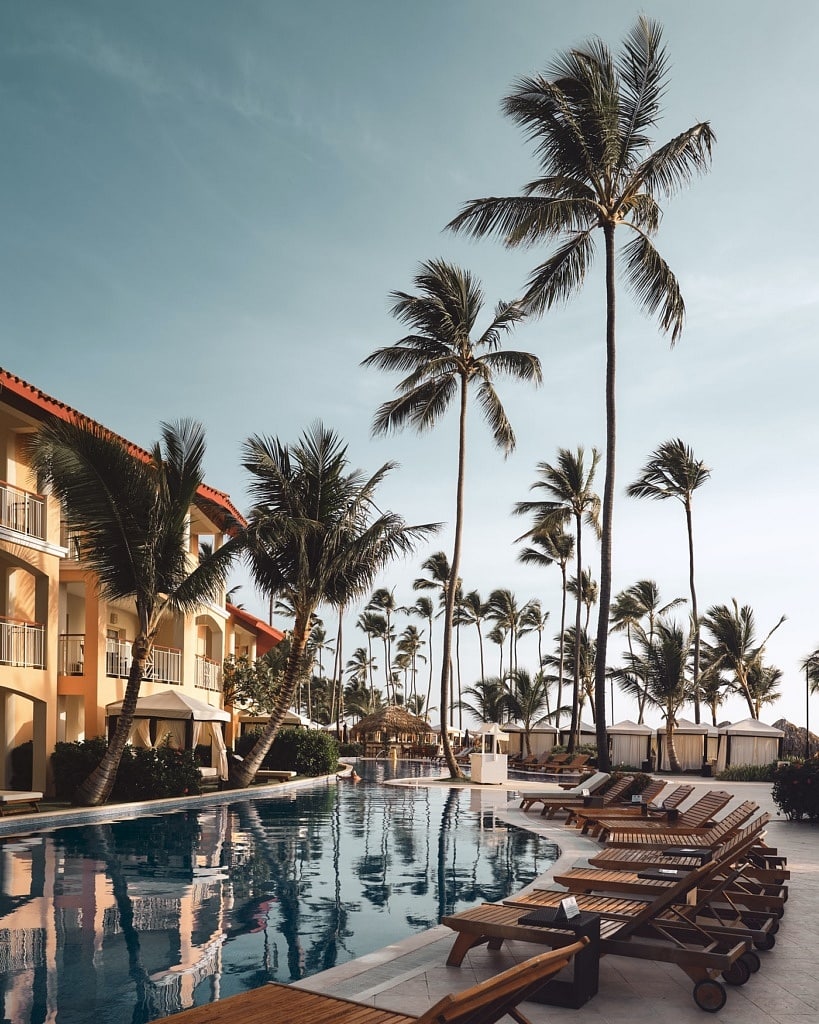

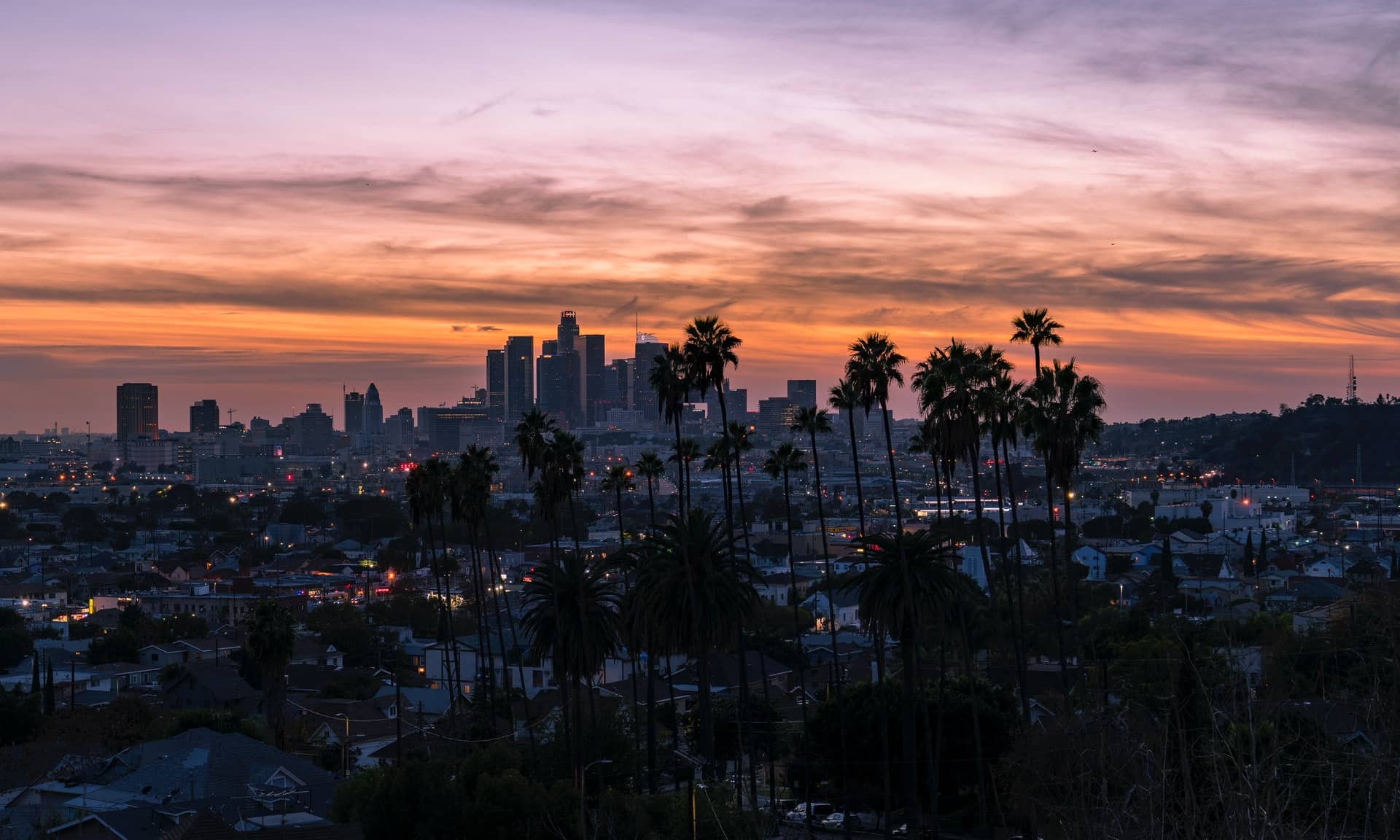








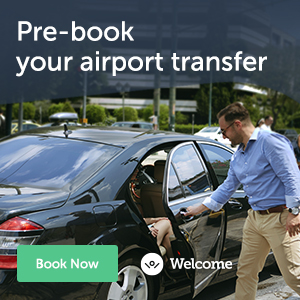

Leave a Reply
View Comments